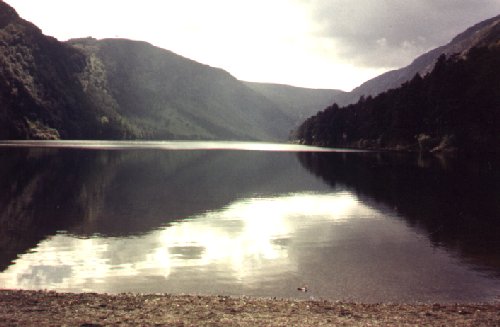|
Glendalough, Gleann dâ Loch, means the "valley of the two lakes". This valley was carved out by a glacier during the ice age. There are now two lakes here and many ancient remains. There is a bronze or iron age fort on the eastern edge of the upper lake. Saint Kevin, AD 528 to 619, founded the monastic settlement at Glendalough. He was said to be a Prince of a Royal Leinster family who were ousted from rule in west Wicklow. No one is quite sure when he arrived in Glendalough but he came to pray and meditate and be a hermit, and so settled in a cave 30ft above the upper lake (seen here). This cave is only 7ft by 4 ft (2 by 1.2 m) in size. The site is known as St. Kevin's Bed. Many disciples followed him and visited the site and it became known as a place for Christian scholarship. Legends grew up around his life. It is said a beautiful woman fell in love with him, but he fearing she would lead him astray threw nettles in her face. She begged his forgiveness and gave herself to a life of piety. Another legend says a water serpent came up out of the lake and destroyed St. Kevin's efforts at building a church. He prayed for help and a giant wolf appeared and ate the serpent, allowing him to continue with his church building. He built his first church near the upper lake, but as the site grew the settlement moved to the edge of the lower lake which is where most of the remains can now be seen. Viking raids from the 9th century did a lot of damage to the settlement here, and there was a fire in 1398 which threw the settlement into decline. There is a round tower here dating from the 10th century. St. Kevin's church is also well preserved. The tower was built around the 12th century and the church itself is older and is a simple one roomed stone structure. It is known as St. Kevin's Kitchen. The Cathedral of St. Peter and St. Paul was built in three distinct phases starting from the 10th century. There is a priests house in the graveyard, dating from the 12th century,was used as a burial place for Priests when Catholicism was suppressed. To the east is a 12th century granite cross some 11 ft high, known as St. Kevin's Cross. There are some seven churches remains here and the graveyard itself is also interesting to see. Gold has been found in Wicklow, but if you look in the water here don't be fooled- there is a lot of "fools gold" or iron pyrite to be found! There are plenty of nice walks to do here, one of which is along the upper lake to where the river enters the valley. Here is the remains of an old tin mine now long disused. There is a modern visitors centre for tourists. |
